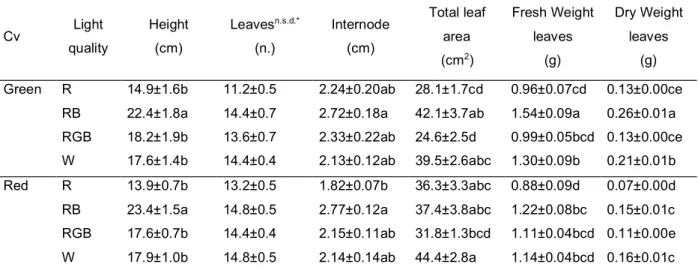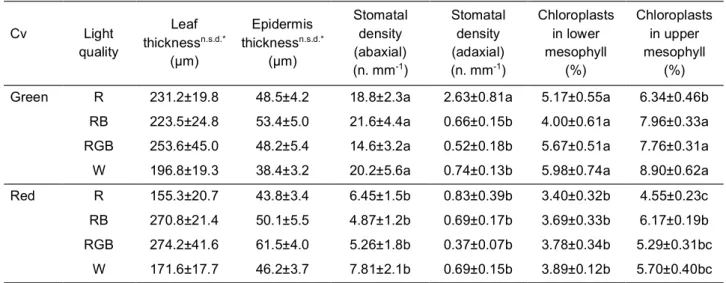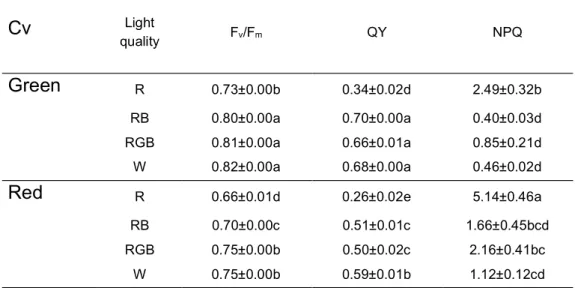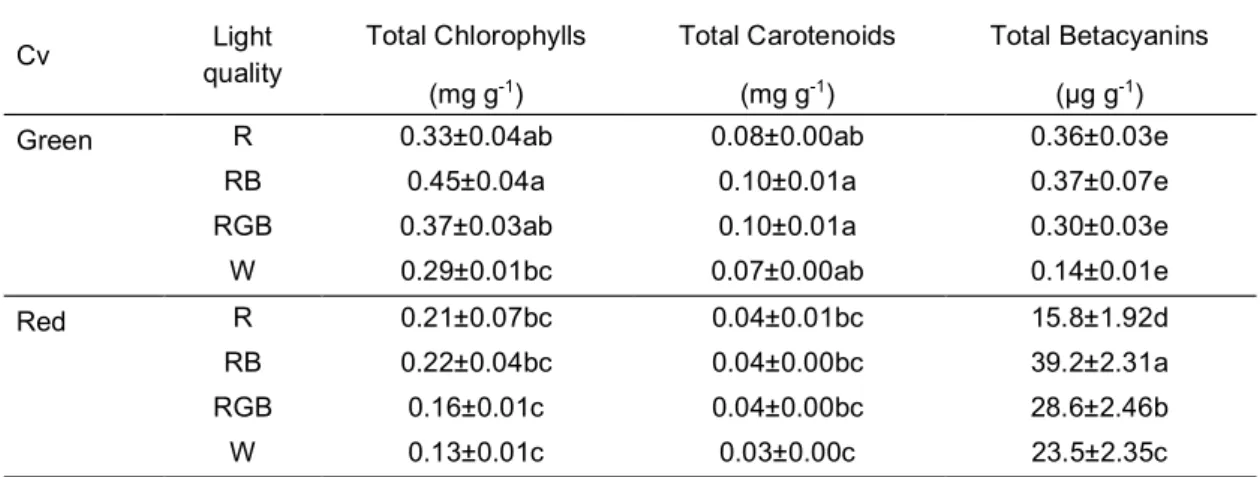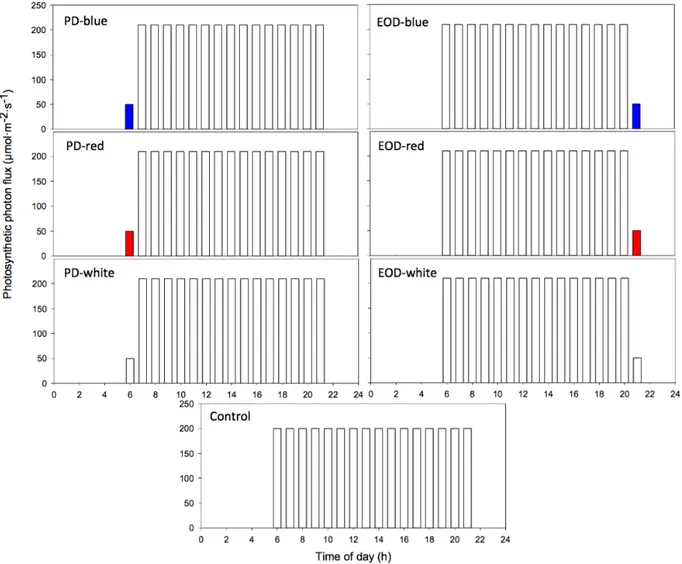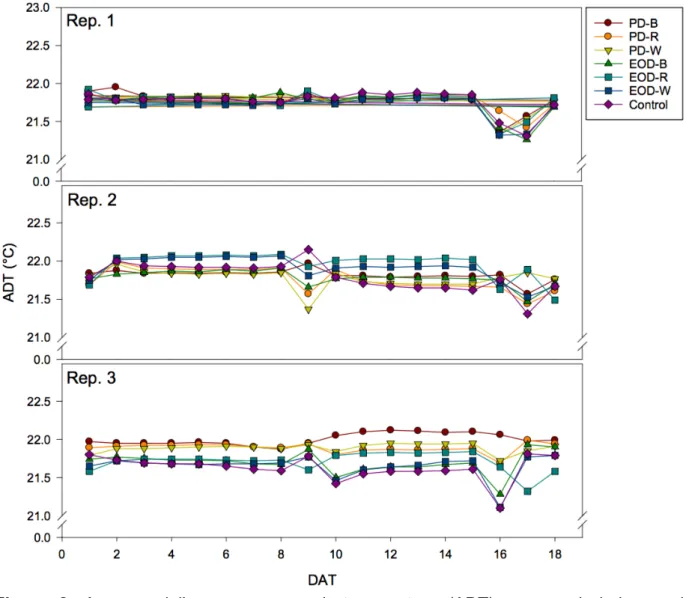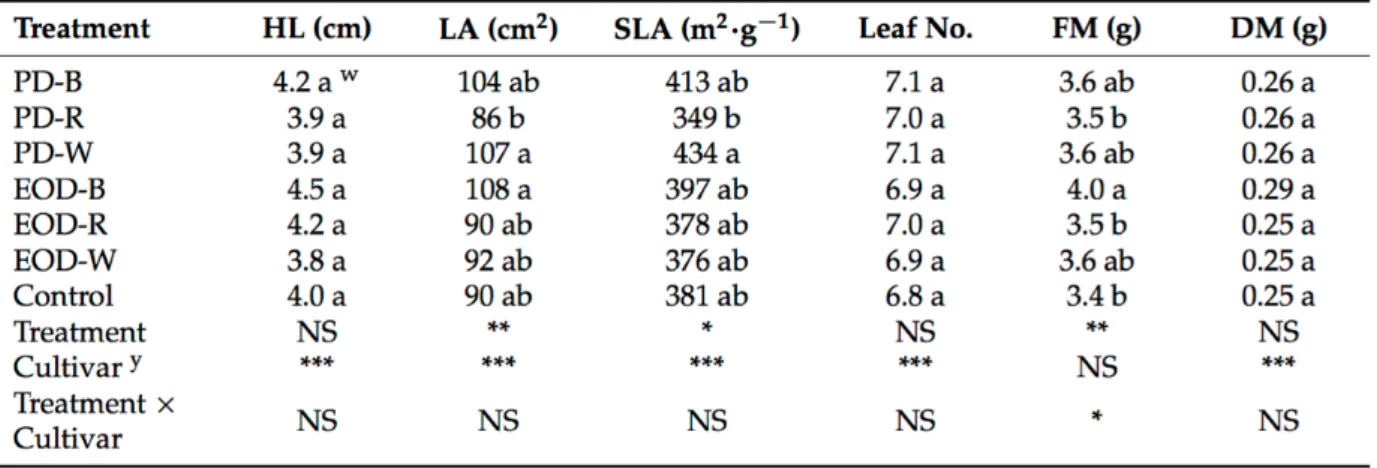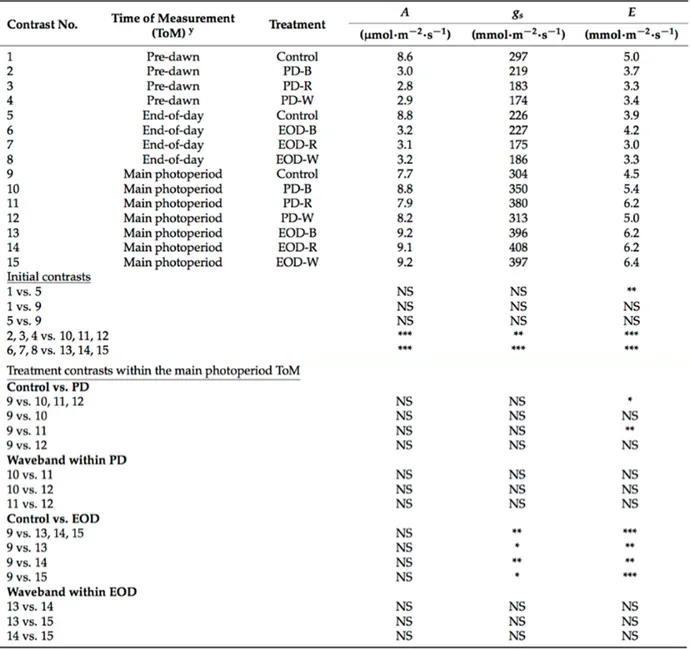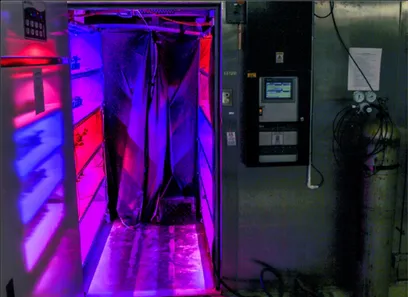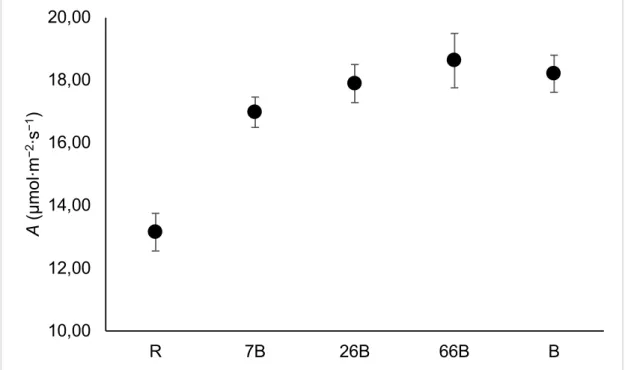U
NIVERSITY OF
N
APLES
F
EDERICO
II
Ph.D. Thesis in Agricultural and Food Sciences
L
UIGIG
ENNAROI
ZZOImproving plant physiological performance
and growth by increasing the efficiency of
lighting systems
Ph.D. Coordinator: Prof. Guido D’Urso
Principal Supervisor: Prof. Giovanna Aronne Co-supervisor: Dr. Carmen Arena
XXXI Cycle
“…whilst this planet has gone cycling on according to the fixed law of gravity, from so simple a beginning endless forms most beautiful and most wonderful have been, and are being evolved.”
The work presented in this thesis was carried out in the period from December 2015 to November 2018 at the Department of Agricultural Sciences and at the Department of Biology of the University of Naples Federico II. Principle supervisor was Prof. Giovanna Aronne and Co-supervisor was Dr. Carmen Arena. A period of six months was spent working with Dr. Celina Gómez in the Environmental Horticulture Department at the University of Florida. The project was funded by the Italian Space Agency (ASI) and the European Space Agency (ESA) within the framework of MELiSSA (Micro-Ecological Life Support System Alternative).
Index
Introduction ... 5
Chapter 1 ... 10
Increasing efficiency of crop production with LEDs ... 11
1.1. Abstract ... 11
1.2. Introduction ... 12
1.3. Monochromatic LEDs for plant production ... 12
1.3.1. Light-quality control of plant growth and development ... 12
1.3.2. Controlling seasonality of flowering plants ... 16
1.3.3. Controlling physiological disorders... 18
1.3.4. Reducing incidence of pest and disease pressure ... 19
1.4. Reductions in energy consumption ... 21
1.4.1. Intracanopy lighting (ICL) ... 21
1.4.2. Targeted lighting ... 22
1.4.3. Dynamic control of LEDs ... 22
1.5. Future of LEDs ... 24
1.5.1. Vertical farms (VFs) ... 24
1.5.2. Space farming ... 25
1.5.3. Off-grid plant production ... 26
1.6. References ... 26
Light quality shapes morpho-functional traits and pigment content of green
and red leaf cultivars of Atriplex hortensis... 37
2.1. Abstract ... 37
2.2. Introduction ... 38
2.3. Materials and Methods ... 41
2.3.1. Plant material and growing conditions ... 41
2.3.2. Lighting treatments ... 42
2.3.3. Quantification of morphological traits ... 42
2.3.4. Microscopy and digital image analysis ... 43
2.3.5. Chlorophyll a fluorescence measurements ... 43
2.3.6. Determination of pigment content ... 44
2.3.7. Statistical analysis ... 44 2.4. Results ... 45 2.5. Discussion ... 49 2.6. Conclusions ... 54 2.6. Conclusions ... 54 2.7. References ... 55 Chapter 3 ... 62
Growth and physiological responses of lettuce grown under pre-dawn or end-of-day sole-source light-quality treatments ... 63
3.1. Abstract ... 63
3.2. Introduction ... 63
3.3. Materials and methods ... 66
3.3.1. Plant material and growing conditions ... 66
2
Index
3.3.3. Data collection and plant measurements ... 68
3.3.4. Data analysis ... 70 3.4. Results ... 70 3.4.1. Growth responses ... 70 3.4.2. Physiological responses ... 71 3.5. Discussion ... 73 3.6. References ... 75 Chapter 4 ... 78
Gas exchange and leaf anatomy of lettuce in response to blue and red LEDs as a sole-source lighting ... 79
4.1. Abstract ... 79
4.2. Introduction ... 79
4.3. Materials and methods ... 81
4.3.1. Plant material and growing conditions ... 81
4.3.2. Lighting treatments ... 81
4.3.3. Growth and morphological measurements ... 82
4.3.4. Physiological measurements ... 83
4.3.5. Anatomical leaf traits measurement ... 83
4.3.6. Data analysis ... 83
4.4. Results ... 83
4.4.1. Growth and morphology ... 83
4.4.1. Physiology ... 84
4.4.1. Anatomy ... 85
4.5. Discussion ... 85
4.7. References ... 88
Chapter 5 ... 91
MULTITROP: an educational and scientific project on root tropism interactions in microgravity ... 92
5.1. Abstract ... 92
5.2. Introduction ... 93
5.2.1. Educational aims and activities ... 93
5.2.2. Theory ... 95
5.2.3. Scientific aims... 95
5.2.4. The challenge to use refurbished hardware ... 96
5.3. Materials and methods ... 97
5.3.1. HW description and constraints ... 97
5.3.2. Pre-flight scientific activities ... 98
5.3.3. Flight activities ... 100
5.3.4. Post-flight activities ... 102
5.3.5. Statistical analysis and data elaboration ... 103
5.4. Results ... 104
5.4.1. Experiment adaptation to the YING B2 hardware ... 104
5.4.2. Substrate selection ... 105
5.4.3. Species selection ... 106
5.4.4. Root orientation on Earth and ISS ... 108
5.5. Discussion ... 109
5.5.1. Refurbishment ... 109
5.5.2. Root tropism interactions on Earth and ISS ... 111
4 Index 5.7. Acknowledgements ... 112 5.8. References ... 113 Conclusions ... 114 Appendix 1 ... 118
ROOTROPS: tackling the roots of bending ... 119
Preface ... 119
Abstract ... 119
General objectives ... 120
Scientific and technical aspects ... 121
Experiment description... 122
Proposed species ... 123
Required hypergravity levels ... 123
Lighting treatments ... 124
Data collection ... 124
Partial-gravity simulation test ... 126
References ... 126 Appendix 2 ... 128 List of publications ... 129 Projects ... 130 Conferences ... 131 Oral presentations ... 132 Posters ... 133
Courses and seminars ... 134
Side activities ... 135
6
Introduction
Plant cultivation in controlled environment has been grown considerably for commercial vegetable production in addition to research purposes in plant science. In a controlled environment, as well as in nature, light is a main factor affecting plant growth, development, and photosynthetic performance. Therefore, the yield and the quality of plant products are highly dependent on the amount of available light and its spectral composition.
Different types of electric lamps, such as fluorescent, high-pressure sodium, and light-emitting diode (LED) are used as a sole source or supplementary source in lighting systems for plant production which energy requirement can be very high. Although most light sources consist of fluorescent lamps due to the low investment costs, LEDs are undoubtedly expanding the technological frontier to increase the efficiency of lighting systems in controlled environment for plant cultivation.
The development of LED-based plant-growth systems has been firstly supported by NASA since the late 1980s, and the first use of LEDs to grow plants in space in 1995 paved the way for the development of the Vegetable Production Chamber (VEGGIE) on the International Space Station. As regards application on Earth, during the last decade the use of LEDs has been gradually increasing worldwide due to their small size, long life, narrow wavelength emission and cool emitting temperature compared with other light sources. These characteristics of LED technology are enabling to design and develop high-performance growth chambers, reducing energy consumption and optimizing cultivation volume in multi-tiered high-density growing systems. Furthermore, LED lamps allow growers to fine-tune the intensity and the spectral quality of the light source to fulfil plant requirements with an accurate species-specific approach in maximizing plant production.
Light interaction with plants is not limited to photosynthesis. In addition to light intensity and quality, plants perceive also light direction which is essential in phototropic responses. Light is a major influential stimulus on plant tropisms,
together with gravity force, and both compete and interact with each other. Considering plant cultivation in altered-gravity environment such as on the ISS, the moon or mars, light plays an unique role as an external stimulus in shaping the plant in a three-dimensional space through photomorphogenesis and phototropism. However, little is known about the interaction between plant tropisms, especially considering tropic responses of roots, and only recently advances in knowledge have been made thanks to the opportunities to experiment in absence of gravity on the ISS combining the use of LED technology.
In this context, a deep understanding of plant responses to the different characteristics of light is needed and the peculiarities of LED technology provide promising opportunities for study and research in the field of plant science.
The study and research activities carried out during this Ph.D. program were focused on plant responses to spectral composition of light by using LED technology. More specifically, the studies considered species suitable for plant production in controlled environment, with particular attention to red-leaf or reddish-leaf plants due to their contribution of antioxidant compounds to plant food.
Given that the general aim of this Ph.D. was to improve plant cultivation in Space, in addition to studies specifically focused on the effect of light on plant growth, part of the research was dedicated to interactions between light and altered gravity. To perform experiments in altered-gravity conditions it was necessary to use specific facilities such as the International Space Station (ISS), the Large Diameter Centrifuge, and the Random Positioning Machine.
For the purposes of these studies, I submitted two projects within the ASI and ESA educational calls. The first, ROOTROPS, was aimed to unravel the interaction between light quality and altered gravity on root orientation. The project was submitted to ESA within the “SpinYourThesis” Call and is now in negotiation phase. The second, MULTITROP, was the only winner of the ASI YiSS call 2016 and was performed on the ISS. Due to technical constraints (necessity to use a refurbished hardware) the experiment had to be performed in the dark. MULTITROP was therefore aimed to investigate on chemotropism-hydrotropism interactions in absence of gravity stimulus. The experiment was successful and we look for another flight opportunity to include light as an additional stimulus.
8
Introduction
Aims and content of each chapter of the thesis are reported hereby.
Chapter 1 is a review which presents the current state of knowledge on the LEDs
applications in plant production and has been published as a review article (Gómez & Izzo, 2018). It covers main important aspects of using light emitting diode technology in controlling the plant growth and development, emphasizing the advantages of using LED light in various horticulture production systems, including future opportunities for the expansion of the vertical farming industry, applications for space-based plant growth systems, and potential solutions to support off-grid agriculture.
Chapter 2 presents evidence on how the modulation of light spectrum can improve
productivity and food quality in controlled environment. The effects of light quality on green- and red- leaf cultivars of Atriplex hortensis, a plant with a high nutritional value currently revalued for leafy vegetable production, were compared. Particular attention was given to the responses of plant pigments to different light treatments aiming at defining optimal light conditions to enhance the production of antioxidant pigments that increase the nutritional value of plant food. A manuscript reporting these data has been published in Scientia horticulturae (Izzo et al., 2019).
In Chapter 3 the effect of small changes in light quality and intensity on the growth and physiological responses of two lettuce cultivars were evaluated. Short-term end-of-day light treatment turned out to effectively modify physiological and morphological plant responses that may ultimately lead to higher yields without increasing the daily amount of light, thus increasing the efficiency of lighting treatment. An article reporting this study has been published (Chinchilla et al., 2018). In Chapter 4 the role of blue and red light on morphological, physiological, and anatomical responses of reddish-leaf lettuce was evaluated performing a dose-response curve between 100% blue light and 100% red light. Blue-light dose turned out to significantly affect lettuce growth. The study has been reported at the “69th International Astronautical Conference” in Bremen and is currently under revision for publication on Acta astronautica journal.
Chapter 5 focuses on tropic responses of plant roots to gravity and other stimuli to
further investigate how not-gravitropic stimuli can direct root growth in altered-gravity conditions. Gravity, nutrient and water interaction of stimuli for root
orientation in microgravity was evaluated reporting a part of the results of the MULTITROP project. As the senior of the three University students in the applicant team, I played a major role in all the activities carried out during the pre-flight, flight and post-flight phases of the experiment. The MULTITROP experiment was performed on the ISS, all aims were achieved and results regarding both methods for seed species selection and root tropism are presented. Some of the results have been reported in two publications: one is available as proceeding of the “2nd Symposium on Space Educational Activities”, and the other presented at the “69th International Astronautical Conference” in Bremen and is currently under revision for publication on Acta astronautica journal.
As last chapter a general conclusion is given. In addition, two Appendices are reported. The first presents ROOTROPS project that aims to evaluate the variations in tropic effects of different light wavelengths and light intensity in orienting root growth under hypergravity and simulated microgravity conditions.
In the second Appendix an outlook on the activities conducted during the Ph.D. program is presented.
Increasing efficiency of crop production with
LEDs
1.1. Abstract
Light-emitting diode (LED) technology is paving the way to increase crop production efficiency with electric lamps. Users can select specific wavelengths to elicit targeted photomorphogenic, biochemical, or physiological plants responses. In addition, LEDs can help control the seasonality of flowering plants to accurately schedule uniform flowering based on predetermined market dates. Research has shown that the monochromatic nature of LEDs can help prevent physiological disorders that are common in indoor environments, and help reduce incidence of pest and disease pressure in agriculture, which could ultimately increase crop production efficiency by preventing crop losses. Furthermore, a significant attribute of LED technology is the opportunity to reduce energy costs associated with electric lighting. Studies have shown that by increasing canopy photon capture efficiency and/or precisely controlling light output in response to the environment or to certain physiological parameters, energy efficiency and plant productivity can be optimized with LEDs. Future opportunities with LED lighting include the expansion of the vertical farming industry, applications for space-based plant growth systems, and potential solutions to support off-grid agriculture.
Abbreviations: CO2: carbon dioxide; DE: day extension; DLI: daily light integral; EOD: end-of-day; HPS: high-pressure sodium; ICL: intracanopy lighting; ISS: international space station; LED: light emitting diode; LD: long-day; NASA: national aeronautics and space administration; NI: night interruption; PAR: photosynthetically active radiation; PD: pre-dawn; PPF: photosynthetic photon flux; RQE: relative quantum efficiency; SD: short-day; UV: ultraviolet; UV-B: ultraviolet-B; VF: vertical farms
12
Chapter 1 1.2. Introduction
The use of light-emitting diodes (LEDs) for plant lighting has revolutionized the greenhouse and controlled-environment industry. Initial interest in LEDs as a radiation source for plants centered on the opportunity to improve light sources for space-based plant growth systems [1–4]. Within the last two decades, horticultural researchers have proven that LEDs can serve as an energy-efficient replacement for incandescent lamps to control photoperiodic responses in flowering plants. Studies have also demonstrated that LEDs are viable alternatives to fluorescent lamps for sole-source lighting in growth rooms, and are currently major competitors of high-pressure sodium (HPS) lamps for supplemental lighting in greenhouses. A myriad of recent studies describe the many advantages of using LEDs for plant production, which range from the application of narrowband radiation to serve as cues that drive specific photomorphogenic, biochemical, or physiological plants responses, to applications for pest and disease management, and reductions in energy consumption from plant lighting. A review of key studies focused on increasing the efficiency of crop production with LEDs, and discussion of current and potential applications follows.
1.3. Monochromatic LEDs for plant production
1.3.1. Light-quality control of plant growth and development
A valuable attribute of using LEDs for plant lighting is the option to select specific wavelengths for a targeted plant response [5]. Broadband red light (600 to 700 nm), which typically promotes dry mass gain, stem elongation, and leaf area expansion of many plants species, has the highest relative quantum efficiency (RQE) for driving single-leaf photosynthesis [6,7]. Initial LED plant-lighting research in the 1990s proved that plants could grow and complete their life cycle with red LEDs alone, but growth and development was significantly improved when red LEDs were supplemented with small proportions of blue light [8–12]. Because blue LEDs were not widely available at the time, initial studies were conducted using red LEDs (660 nm) supplemented with blue fluorescent lamps.
Relative quantum efficiency curves indicate that broadband blue light (400 to 500 nm) is 25 to 35% less efficient that red light in driving single-leaf photosynthesis [6,7]. Cope et al. [13] described the potential factors that limit the RQE of blue light for photosynthesis: (1) approximately 20% of blue photons are absorbed by non-photosynthetic pigments (e.g. anthocyanins), which result in energy lost as heat and/or fluorescence; and (2) some blue photons are absorbed by accessory pigments (e.g., carotenoids), which can be 10 to 65% less efficient than chlorophyll molecules at transferring light-energy to the photosynthetic reaction center [13]. However, studies have shown that up to a species- or cultivar-specific threshold, increasing the proportion of blue light can increase single-leaf photosynthetic capacity and efficiency [14,15]. Increasing blue light often inhibits cell division and expansion, reducing leaf area (i.e., radiation capture) and stem elongation and increasing leaf thickness in most plant species. Bugbee [16] suggested that the reduction in radiation capture is the primary reason for reduced growth (dry mass gain) in response to higher blue light. Blue light is also known to affect leaf stomatal aperture, regulate chloroplast development, and control photomorphogenic and phototrophic plant responses primarily through the action of cryptochrome and phototropin photoreceptors [17–19]. Several studies indicate that 5 to 20% of blue light within the total photosynthetic photon flux (PPF) is needed to improve growth and development and minimize shade-avoidance responses (e.g., elongated internodes, petioles, and hypocotyls, larger, thinner leaves, decreased chlorophyll production, and early flowering) in controlled environments [10,20–24].
A general conclusion from sole-source light-quality research suggests that plant responses to LEDs are species- and sometimes cultivar-specific, and greatly depend on the stage of plant development, light intensity, duration of treatment, or other environmental interactions [23]. Dissolved chlorophyll pigments absorb light most effectively in the red and blue regions of the photosynthetically active radiation (PAR) spectrum (400 to 700 nm). Therefore, early LED systems were equipped with red and blue LEDs alone. However, because other accessory pigments (e.g., carotenoids) efficiently absorb much of the light that is poorly absorbed by chlorophyll, plants can use most of the light within PAR for photosynthesis [25]. Thus, commercial fixtures for plant production now include LEDs with peak
14
Chapter 1
wavelengths beyond red and blue. In fact, white LED fixtures are increasingly being used in growing environments because they help overcome some of the complications involving LED color selection and, depending on the desired growth characteristic, may minimize unwanted responses from the range of possible plant responses to narrowband red and blue light [26]. White LED fixtures can be produced either by combining LEDs with different peak wavelengths or, more commonly, by using blue LEDs with a phosphor coating. At the expense of efficiency, the phosphor absorbs some fraction of the photons emitted by the blue LEDs and re-emits light with longer wavelengths through luminescence, generating white light [27]. The components of the phosphor coating will typically dictate the percentages of red, green, and blue light available for plant growth with broadband white LEDs.
Although green (500 to 600 nm) and far-red light (700 to 800 nm) are often disregarded as useful wavebands for photosynthesis because of their minimal absorption by chlorophyll pigments, studies suggest that they can have positive direct and indirect effects in plant growth and photosynthesis. Because red and blue photons are efficiently absorbed by chlorophyll, most red and blue light is absorbed within a few cell layers from the leaf surface, while green photons can penetrate deeper into the leaf [28]. Accordingly, Sun et al. [29] found that red and blue light drive CO2 fixation primarily in the upper palisade mesophyll of the chloroplast, while green light drives CO2 fixation in the lower palisade. Similarly, Terashima et al. [30] reported that with high PPF, once the upper chloroplasts of individual leaves are saturated by white light, additional green light can increase photosynthesis by penetrating deeper into the leaf and driving CO2 fixation of inner chloroplasts that are not light-saturated by white light. Green light has also been shown to penetrate deeper into the foliar canopy than red and blue light, and can therefore increase whole-plant photosynthesis by stimulating CO2 fixation of inner- and lower-canopy leaves [31–33]. What’s more, depending on species, the RQE of absorbed broadband green light can be comparable with that of red, and higher than that of blue [6,7]. Another useful feature of green LEDs, particularly when used to create white light with narrowband red and blue LEDs, is that it can allow for a better visual
assessment of plant-status and true-leaf color, something that is typically hard to do when plants are irradiated with purple light from red and blue LEDs only.
Far-red wavelengths can regulate phytochrome-mediated morphological and developmental plant responses. In an effort to promote radiation capture and survival under a low red-to-far red spectra (i.e., similar to shade), plants develop a shade-avoidance response resulting in stem elongation and larger, thinner leaves. Park and Runkle [34] found that supplementing red and blue LEDs with far-red increased plant growth indirectly through leaf expansion, and directly through an increase in whole-plant net assimilation, defined as the rate of increased dry mass per unit leaf area. Zhen and van Iersel [35] evaluated the potential of enhancing photosynthesis in plants grown under red + blue or broadband white LEDs supplemented with far-red LEDs. The authors found that far-red light, which preferentially excites photosystem I, can increase the photosynthetic efficiency of shorter-wavelengths that over-excite photosystem II; their findings prove that different wavelengths of light can have synergistic effects that improve the overall rate of photochemistry and CO2 assimilation [35]. Both of these studies suggest that adding far-red to fixtures with monochromatic LEDs could improve photosynthetic light-use efficiency and increase crop growth in controlled environments.
Except for studies evaluating photoperiodic control of flowering plants, most horticultural research focused on plant growth-responses to LEDs have used a constant spectral environment throughout the day, and typically, during an entire crop cycle. However, dynamic control of LED-light quality can provide the opportunity to change the spectral environment overtime, which may be required to optimize growth and development throughout a plant’s life cycle. Several studies have demonstrated that end-of-day (EOD) (i.e., light applied at the end of the photoperiod) far-red can be used as an effective non-chemical means to control plant morphology in a number of crops [36–42]. Moreover, short-term exposure to pre-dawn (i.e., light applied before the start of the photoperiod) or EOD light-quality treatments can have significant effects on plant growth and morphology [43–46]. Although the mechanisms that drive biomass increase under short exposure to PD or EOD-light are unknown, they may be related to hormonal changes that affect the circadian rhythm of plants and induce instantaneous changes in stomatal
16
Chapter 1
conductance and transpiration, which have been shown to strongly respond to light quality [15,47,48].
As stated by Mitchell and Stutte [26], there is no single light-quality recipe that serves all species and every stage of plant growth. However, a compromise between red and blue LEDs can typically drive photosynthesis and regulate vegetative growth of most plants. As suggested by Cope and Bugbee [20], it is likely that the optimal light spectrum for plant growth and development changes with plant age, as plants need to balance leaf area expansion (to maximize radiation capture) with stem elongation and reproductive growth. A thorough understanding of the energy balance needed by plants to regulate growth throughout their life cycle is essential to the development of LED light sources for plant applications. Furthermore, it is important to consider that plants grown indoors are typically exposed to a light spectrum that depends on the electric-lamp type used. In contrast, greenhouse-grown plants develop under broad-spectrum sunlight and sometimes receive supplemental lighting from a specific spectra provided by electric lamps. Thus, if LEDs are used to supplement sunlight, additional blue light may not be as critical as it seems to be for indoor production; that is because sunlight’s broad spectrum contains significant amounts of blue light at midday, which may be sufficient for normal plant growth and development [49]. In addition, because supplemental lighting typically constitutes only a fraction of the total irradiance received by plants, mostly during light-limited periods, photomorphogenic and physiological disorders that have been reported for plants grown under narrowband lighting in growth chambers (see Controlling physiological disorders) are potentially less likely to occur in greenhouse production using narrowband supplemental lighting.
1.3.2. Controlling seasonality of flowering plants
Similar to growth and development, flowering responses to light quality are species- or cultivar-specific and are primarily determined by the duration of the continuous dark period within a day, also known as the critical night length [50]. Plants are typically classified into response groups based on how that critical night length affects flower regulation. Day-neutral plants flower regardless of photoperiod,
assuming other environmental and cultural factors are not limiting. Short-day (SD) plants flower most rapidly when uninterrupted dark periods are longer than some species-specific critical night length. In contrast, flower induction of long-day (LD) plants is most rapid when dark periods are shorter than a critical duration. Therefore, when the photoperiod is short, longer days (i.e., shorter nights) from day-extension lighting with electric lamps can induce flowering of LD plants or inhibit flowering of SD plants to enable vegetative growth. Similarly, night interruption (NI) or PD lighting can be effective at interrupting the dark period and thus, promoting LD photoperiodic responses [51,52]. However, NI has been shown to induce flowering in LD plant more effectively than day extension or PD lighting [50].
In addition to a critical night length, light quality is essential to control the seasonality of flowering plants. Red and far-red light-absorbing phytochromes are the primary photoreceptors that regulate flowering of photoperiodic species, although blue light, which is also weakly absorbed by phytochromes, has been shown to regulate flowering at higher intensities (e.g., 30 μmol∙m−2∙s−1) than the typical <2 μmol∙m−2∙s−1 required from red and/or far-red light [53–56].
In the floriculture industry, commercial growers typically extend or truncate the photoperiod to accurately schedule uniform flowering of most photoperiodic-sensitive species based on a predetermined market date (e.g., mother’s day, Easter, Christmas). Because of their high far-red photon emission, incandescent light bulbs used to be the lamp of choice for low-intensity photoperiodic lighting. However, with the advancement of LEDs, incandescent bulbs were quickly replaced as photoperiodic lamps because of their short-life span, and more importantly, because they were being phased out of production in many countries due to their electrical inefficiency [57,58]. Compact fluorescent lamps are more energy efficient and longer lasting than incandescent bulbs. However, their spectra has little or no effect on regulating flowering [58]. The narrow bandwidth of LEDs makes precise control of light quality possible, which has significantly broadened our understanding of how different wavebands regulate flowering. Compared to incandescent bulbs, LEDs provide significant advantages such as reducing energy and maintenance costs, accelerating flowering, or preventing excessive stem elongation in some plant species.
18
Chapter 1
In a coordinated greenhouse grower trial, Meng and Runkle [59] compared LED lamps emitting primarily red and far-red radiation with incandescent bulbs to create LDs with NI; the authors confirmed that LEDs were as effective as incandescent bulbs at regulating flowering of several herbaceous ornamental crops. However, research has shown that not all LED lamps are effective at regulating flowering; their effectiveness depends on their spectral composition. Craig and Runkle [60] found that a balanced combination of red and far-red radiation from LEDs promotes flowering of several LD plants. In contrast, red-enriched radiation with LEDs works best at delaying flowering in SD plants [61]. Furthermore, Meng and Runkle [62,63] reported that NI with low far-red radiation from LEDs may not be perceived as a LD; the authors suggested that LD plants can be classified into far-red-dependent and far-red-neutral varieties based on their flowering responses to far-red radiation. Meng and Runkle [62] also found that cool-white LEDs and warm-white LEDs have a similar effectiveness at regulating flowering than red or blue + red LEDs. Relatively few studies have explored the efficacy of green radiation at regulating photoperiodic flowering. Under SDs, NI or DE (day extension) with low or high intensity green LEDs were shown to inhibit flowering of SD plants [64–66]. However, similar to blue-light flowering responses, the degree of flowering regulation with green LEDs seems to depend on intensity and/or treatment duration, and are most likely species-specific. Meng and Runkle [55] suggested that because green radiation can exert an inhibitory flowering effect in some species similar to that of low-intensity red light, a combination of green and red LEDs could be more effective at inhibiting flowering of SD plants than either waveband alone. Lastly, flowering responses to light quality also seem to be dependent on daily light integral (DLI), which refers to the cumulative number of photons within PAR received during a 24h period. Kohyama et al. [67] found that adding far-red to red + white radiation in NI promotes flowering of some ornamental species under a low DLI (≤6 mol∙m−2∙d−1) but not under a DLI <12 mol∙m−2∙d−1.
1.3.3. Controlling physiological disorders
The monochromatic nature of LEDs can lead to physiological disorders in some plant species or cultivars that are typically not present when plants are grown under
broadband light. For example, intumescence, a cultivar-specific physiological disorder that is characterized by abnormal outgrowth of cells on plant surfaces (typically induced by abiotic stress), was first associated with a lack of ultraviolet (UV; 300 to 400 nm) and far-red radiation in the spectral environment [68,69]. Others have found that UV radiation can prevent intumescence development on susceptible cultivars of tomato (Solanum lycopersicum) and ornamental sweet potato (Ipomoea batatas) [70–72]. Similarly, far-red and/or blue light have been shown to mitigate intumescence injury in tomato and cowpea (Vigna unguiculata) in UV-deficient light environments [5,69,73–75]. Due to the damage in the photosynthetic tissue, intumescence not only impairs the physiological processes of plants, but also negatively affects the overall aesthetic quality of plant products, which is a significant concern with ornamental crops grown under sole-source lighting with narrowband LEDs.
As previously mentioned, red light alone can result in suboptimal growth and development of many plant species [8,10–12,14]. Research has shown that 100% red light can lead to physiological disorders that can result in undesirable stem elongation and/or deficient chlorophyll biosynthesis, leading to low photosynthetic rates due to a dysfunctional photosynthetic apparatus [15,76,77]. The mechanisms behind the suboptimal growth under monochromatic red light are not yet fully understood and seem to be species-specific, as some plants have been shown to produce higher biomass under 100% red light compared to a combination of wavelengths [75,78,79].
1.3.4. Reducing incidence of pest and disease pressure
Irradiating plants with specific wavebands of LEDs has potential for reducing pest pressure and suppressing plant disease in production environments, which could ultimately increase crop production efficiency by preventing crop losses. The role of light quality in plant disease resistance has been correlated with light-induced signaling pathways that interact with plant-defense regulatory mechanisms. Effects of light quality on secondary metabolite accumulation (e.g., flavonoids) have been associated with plant immunity, disease development, and insect interactions [80– 82]. A large number of studies have reported increases in light-quality-induced
20
Chapter 1
secondary metabolite as means to increase nutritional attributes of plant products [83]. However, fewer studies have focused on evaluating the level of plant protection in response to light-induced, metabolite-based resistance.
Ultraviolet LEDs, namely those with peak wavelengths in the ultraviolet-B (UV-B; 320 to 290 nm) region of the spectrum, can effectively control powdery mildew caused by Sphaerotheca aphanis in strawberry (Fragaria × ananassa) [84] and
Podosphaera pannosa in rose [85]. Similarly, blue LEDs have been shown to inhibit
the development of Botrytis cinerea in detached tomato leaves and, when used as PD and EOD treatments, can reduce incidence of black leaf mold (Pseudocercospora fuligena) in greenhouse-grown tomato [86,87]. Green LEDs have been proven to be effective for controlling strawberry anthracnose (Glomerella
cinglata) [88], leaf spot disease (Corynespora cassiicola) in perilla (Perilla frutescens) [89], and cucumber anthracnose (Colletotrichum orbiculare) and gray
mold (Botrytis cinerea) [90]. It has also been reported that red LEDs can induce resistance to powdery mildew caused by Podosphaera pannosa in roses [91],
Sphaerotheca fuliginea in cucumber (Cucumis sativus) [92], and downy mildew in
basil caused by Peronospora belbahrii [93].
The use of narrowband LEDs is also a promising approach for increasing the attractiveness, specificity, and adaptability of conventional insect traps. Adding UV, green, and/or yellow LEDs to insect traps has been shown to increase the capture efficacy of fungus gnats (Bradysia difformis), greenhouse whitefly (Trialeurodes
vaporariorum), oriental fruit fly (Bactrocera dorsalis), biting midges (Culicoides brevitarsis), red flour beetle (Tribolium castaneum), sweet photo weevil (Euscepes postfasciatus), and cotton bollworm (Helicoverpa armigera), among others,
compared to non-LED-supplemented traps [94–103].
A variety of factors can influence the effectiveness of light quality to reduce incidence of pest and disease pressure, including the specific peak wavelength of LEDs, light intensity, and time of exposure. However, with the advancement of LED technologies, there is an increasing interest in using light quality as an integral component of pest management programs that can reduce the dependence on environmentally hazardous pesticides. Although research has shown that LEDs can suppress some diseases and reduce pest pressure that are of economic importance
in major crops, consideration should be placed to the indirect effects that applying this light-quality treatments will have on plant growth and development.
1.4. Reductions in energy consumption
The cost of electricity to provide electric light in controlled and semi-controlled (greenhouse) environments is high. In 2014, Nelson and Bugbee [104] published an economic analysis comparing electric costs of using multiple lighting technologies, including ten types of LED fixtures. The authors concluded that the cost per photon delivered from LEDs was higher than that of all traditional horticultural lamps (e.g., HPS, cool-white fluorescent, metal halide), and that at the time, the best HPS and LED fixtures had nearly identical efficiencies (μmol∙J−1) [104]. More recently, Wallace and Both [105] compared the energy efficiency of various LED and HPS lamps and also concluded that the best HPS and LED fixtures had similar efficiency. However, electrical efficiency of LEDs continues to increase, and as the technology improves and the capital cost for purchasing LED equipment decreases, the cost per photon will likely continue to decrease. Moreover, if canopy photon capture efficiency is maximized, lighting system efficiency of LEDs can be significantly increased by capitalizing from “precision lighting”.
1.4.1. Intracanopy lighting (ICL)
The relative coolness (i.e., low radiant heat output) of LED surfaces allows for high flexibility in lamp placement and resulting light distribution within plant canopies. The ability to focus radiation close to plant canopies means that less energy is needed to achieve target PPFs than if a hot light-source is located further away from the crop surface. In an effort to increase the efficiency of irradiation by allowing direct light into the inner canopy of crop stands, Frantz et al. [31,106] performed initial proof-of-concept studies with ICL using 15-watt fluorescent lamps; the authors demonstrated that by maintaining irradiance of the inner foliar canopy above the light-compensation point, ICL-grown cowpea could yield 50% of the edible biomass using only 10% of the total input energy compared to traditional top lighting. Subsequently, when LEDs became readily available for research, Massa et al. [107]
22
Chapter 1
validated previous ICL studies using LED “lightsicles” that were individually energized at different vertical planes to keep pace with plant growth. Others have confirmed that ICL with LEDs can prevent a decrease in photosynthesis and premature senescence of lower-canopy leaves grown with sole-source lighting [107] or supplemental lighting [108–111]. Moreover, Gómez and Mitchell [112] reported significant energy savings from supplemental lighting when using ICL with LEDs compared to HPS lamps. In contrast, Dueck et al. [108] reported an increase in energy consumption when growing tomatoes with intracanopy supplemental lighting with LEDs. However, the higher energy consumption was attributed to the higher heating requirements with LEDs compared to HPS, as ‘waste’ thermal energy from HPS lamps typically helps offset winter heating costs in greenhouses [113].
1.4.2. Targeted lighting
Because ‘waste’ heat is removed remotely from the photon-emitting surface of LEDs, lamps can be placed close to crop surfaces without overheating or scorching plants. Moreover, because LEDs and their fixtures can be designed to cast narrow beams of light, targeted lighting can be applied by selectively switching on LEDs positioned directly above individual plants as they grow. Poulet et al. [21] reported that targeted, close-canopy lighting of lettuce using red and blue LEDs reduced energy consumption per unit dry mass by 32 or 50% compared to total coverage sole-source lighting using either broadband LEDs or red + blue LEDs, respectively.
1.4.3. Dynamic control of LEDs
An underutilized property of LED fixtures is their ability to precisely control PPF with dimming in response to the environment or to certain physiological parameters. As described by van Iersel [114], controlling the intensity of the light output of LEDs can be accomplished using one of two methods: (1) current control or pulse width modulation (i.e., control of the frequency at which LEDs are turned on and off; typically thousands of times per second); or (2) duty cycle control (i.e., fraction of time the LEDs are energized during each on/off cycle).
Pinho et al. [115] evaluated dynamic lighting as a way to control LED supplemental lighting; their system automatically compensated for variation of sunlight PPF at plant canopy level. The authors used an on-off switching algorithm in order to maintain a constant PPF with LEDs and reported a 20% reduction in energy consumption compared to HPS lamps [115]. Similarly, Clausen et al. [116] and Schwend et al. [117] reported 25% and 21% reduction in energy consumption, respectively, when sensor-based dynamic LED lighting was adjusted based on the environment. More recently, van Iersel and Gianino [118] demonstrated that by adjusting the duty cycle of LEDs based on the ability of plants to use light efficiently, an adaptive LED light controller can reduce the energy costs of supplemental LED lighting by preventing the PPF at canopy level from dropping below a user-defined threshold. In practice, their system allows for supplemental lighting with LED fixtures to automatically provide more light when there is little sunlight and dim as the amount of sunlight increases [118]. Early trials with this adaptive system showed that energy consumption can be reduced by 60% with only a 10% decrease in crop biomass, as compared to timer-controlled LED fixtures [119]. In a separate set of studies, van Iersel et al. [120,121] focused on adjusting PPF based on the physiological properties of crops, rather than on changing light intensities. They showed that a biofeedback system that relies on a chlorophyll fluorometer and a quantum sensor to measure the quantum yield of photosystem II and PPF, respectively, can determine the electron transport rate, compare that value to a user-defined threshold, and then change the light output of the LED light (either by changing the duty cycle or current) to maintain a range of different electron transport rates in a variety of species [120,121]. Similarly, Carstensen et al. [122] used a remote-sensing approach with a spectrophotometer to sense the dynamics of chlorophyll fluorescence emission from a plant canopy; the authors developed a model that appears to be indicative of the light-use efficiency and light-induced stress of plants [122]. As shown in these studies, dynamic control of LED lighting can help optimize energy efficiency and plant productivity with LEDs.
24
Chapter 1 1.5. Future of LEDs
1.5.1. Vertical farms (VFs)
Commercial VFs produce high-value plant products in multi-tiered, high-density growing systems. As suggested by others [123], LEDs are adequate candidates for sole-source photosynthetic lighting in VFs because fixtures typically have low power density per unit growth area (kW∙m‒2) and can deliver high light intensities with low radiant heat delivered to crops. Initial efforts to produce high-value crops in warehouse-based plant factories used water-cooled HPS lamps; however, the high-energy consumption needed to produce with HPS lamps negated economic viability [26]; follow-up research used fluorescent lamps, which became standard in controlled environments [124]. However, LEDs are now widely used in VFs in Asia and are gaining popularity in other countries, where commercial VFs produce a variety of leafy greens, young plants, and low-profile fruit crops. Kozai et al. [125] includes a comprehensive review of the of the many potential applications of LEDs in urban agriculture. Akiyama and Kozai [126] described the impact of LED fixture design (lamp and plant spacing) on the spatial distributions of PPF in a simulated VF. Ibaraki [127] showed that depending on canopy structure, LEDs can be used to control the direction of light and reduce the distance between lamps and plants, thus maximizing light-use efficiency in terms of irradiance (W∙m−2) and PPF (μmol∙m−2∙s−1). According to Hayashi [128], improvements in cost reduction, energy efficiency, quality, intensity, and flexibility of LED fixtures have driven VF research in Japan, the Netherlands, England, Taiwan, South Korea, and the U.S. In addition, future projects are targeting applied research to support relevant VF concepts in the Middle East, Central and South America, and Africa. Currently, the VF industry in North America is considered to be in its initial stage, with many entrepreneurs and growers investing in different lighting technologies given the lack of an acceptable business model or standard method of implementing LED technologies [129]. However, some expect that the increasing number of horticultural-grade LED manufacturers will establish models to help improve production efficiency with standardized light-quality formulas and suggested methods for minimizing production costs [130]. One critical aspect to consider is the cost-effectiveness of
VF, particularly when used to produce food crops. Most Asian and European countries that have successfully adopted VF with LEDs have land and/or environmental limitations for producing high-quality fresh food, which, coupled with food-safety concerns, justify the high sale-value in those regions of the world. However, research has shown that although some U.S. consumers are willing to pay premium prices for locally-grown produce, the average consumer is hesitant to purchase costly food grown in VFs [131]. Moreover, Yano et al. [132] showed that consumers believe that LEDs could negatively affect the nutritional attributes and overall taste desirability of plant products. There is a need to improve public perception about VF in an effort to establish a reliable consumer base that will drive the industry forward.
1.5.2. Space farming
The development of LED-based plant growth systems has been supported by NASA since the late 1980s for research in the International Space Station (ISS), to evaluate bioregenerative life-support systems, and to support future colonies on the Moon and Mars [133,134]. The first use of LEDs to grow plants in space in 1995 [135] paved the way for the development of the Vegetable Production Chamber (VEGGIE), which has demonstrated the feasibility of supporting a space garden in the ISS [136,137]. Mitchell et al. [138] estimated that up to 50 m2 of cropping area are needed to sustain one crewmember on a mission, which highlighted a challenging energetic cost for the NASA Biomass Production Chamber [139]. In this context, LEDs play a key role at enabling energy-affordable food production in controlled environments intended for life support in space [21,107,112,140]. Furthermore, the small size of LEDs contribute to reducing the equivalent system mass of a lighting system, which can attenuate the overall cost of a space mission [141]. Another attractive feature of LEDs for space applications is that their long lifetime and reliability can significantly reduce maintenance costs and astronaut labor requirements for plant growth systems [142]. In addition, the solid-state electronics of LEDs ensure safety and affordable risk management strategies that are highly important in manned space missions [2]. The influence of the space-flight
26
Chapter 1
environment on plant growth has been highlighted in several studies [143–148], which indicate that there is a critical need to conduct research that will support the goal of providing efficient plant-based bioregenerative life support systems in extreme environments (e.g., altered gravity, ionizing radiations, ultradian rhythms). The implementation of LEDs in the ISS laboratories allows evaluations of important questions in fundamental biology aiming at improving our knowledge about plant production in space [149,150].
1.5.3. Off-grid plant production
Improvements in robustness and cost reduction of LEDs have made access to electric lighting a reality for rural communities that used to solely depend on fuel-based lighting [151]. The low-energy requirement of LEDs in combination with photovoltaics has led to the development of solar-powered LED systems, which may offer significant opportunities for off-grid agricultural applications [152].
1.6. References
1. Barta DJ, Tibbitts TW, Bula RJ, et al. (1992) Evaluation of light-emitting diode characteristics for a space-based plant irradiation source. Adv Space Res 12: 141– 149.
2. Bula RJ, Morrow RC, Tibbitts TW, et al. (1991) Light-emitting diodes as a radiation source for plants. HortScience 26: 203–205.
3. Emmerich JC, Morrow RC, Clavette T, et al. (2004) Plant research unit lighting system development. SAE Technical Paper Series: 2004-01-2454.
4. Morrow RC, Duffie NA, Tibbitts TW, et al. (1995) Plant response in the ASTROCULTURE flight experiment unit. SAE Technical Paper Series: 951624.
5. Massa GD, Kim HH, Wheeler RM, et al. (2008) Plant productivity in response to LED lighting. HortScience 43: 1951–1956.
6. Inada K (1976) Action spectra for photosynthesis in higher plants. Plant Cell Physiol 17: 355–365.
7. McCree KJ (1972) The action spectrum absorptance and quantum yield of photosynthesis in crop plants. Agric Meteorol 9: 191–216.
8. Brown CS, Schuerger AC, Sager JC (1995) Growth and photomorphogenesis of pepper plants under red light-emitting diodes with supplemental blue or far-red lighting.
J Am Soc Hortic Sci 120: 808–813.
9. Goins GD, Yorio NC, Sanwo-Lewandowski MM, et al. (1998) Life cycle experiments with Arabidopsis grown under red light-emitting diodes (LEDs). Life Support Biosph Sci 5: 143–149.
10. Hoenecke ME, Bula RJ, Tibbitts TW (1992) Importance of blue photon levels for lettuce seedlings grown under red-light-emitting diodes. HortScience 27: 427–430.
11. Tripathy BC, Brown CS (1995) Root-shoot interaction in the greening of wheat seedlings grown under red light. Plant Physiol 107: 407–411.
12. Yorio NC, Wheeler RM, Goins GD, et al. (1998) Blue light requirements for crop plants used in bioregenerative life support systems. Life Support Biosph Sci 5: 119–128. 13. Cope KR, Snowden MC, Bugbee B (2014) Photobiological interactions of blue light and
photosynthetic photon flux: effects of monochromatic and broad-spectrum light sources. Photochem Photobiol 90: 574–584.
14. Goins GD, Yorio NC, Sanwo MM, et al. (1997) Photomorphogenesis, photosynthesis, and seed yield of wheat plants grown under red light-emitting diodes (LEDs) with and without supplemental blue lighting. J Exp Bot 48: 1407–1413.
15. Hogewoning SW, Douwstra P, Trouwborst G, et al. (2010) An artificial solar spectrum substantially alters plant development compared with usual climate room irradiance spectra. J Exp Bot 61: 1267–1276.
16. Bugbee B (2016) Toward an optimal spectral quality for plant growth and development: the importance of radiation capture. Acta Hort 1134: 1–12.
17. Assmann SM, Shimazaki K-I (1999) The multisensory guard cell. Stomatal responses to blue light and abscisic acid. Plant Physiol 119: 809–815.
18. Kaufman LS (1993) Transduction of blue-light signals. Plant Physiol 102: 333–337. 19. Lin C, Ahmad M, Cashmore AR (1996) Arabidopsis cryptochrome 1 is a soluble protein
mediating blue light-dependent regulation of plant growth and development. Plant J 10: 893–902.
20. Cope KR, Bugbee B (2013) Spectral effects of three types of white light-emitting diodes on plant growth and development: absolute versus relative amounts of blue light.
HortScience 48: 504–509.
21. Poulet L, Massa GD, Morrow RC, et al. (2014) Significant reduction in energy for plant-growth lighting in space using targeted LED lighting and spectral manipulation. Life
Sciences in Space Research 2: 43–53.
22. Smith H, Whitelam GC (1997) The shade avoidance syndrome: multiple responses mediated by multiple phytochromes. Plant Cell Environ 20: 840–844.
23. Snowden MC, Cope KR, Bugbee B (2016) Sensitivity of seven diverse species to blue and green light: interactions with photon flux. Plos One 11: e0163121.
24. Wang XY, Xu XM, Cui J (2015) The importance of blue light for leaf area expansion, development of photosynthetic apparatus, and chloroplast ultrastructure of Cucumis
sativus grown under weak light. Photosynthetica 53: 213–222.
25. Ouzounis T, Rosenqvist E, Ottosen CO (2015) Spectral effects of artificial light on plant physiology and secondary metabolism: a review. HortScience 50: 1128–1135.
26. Mitchell CA, Stutte GW (2015) Sole-source lighting for controlled-environment agriculture. NASA Technical Reports.
27. Chen L, Lin CC, Yeh CW, et al. (2010) Light converting inorganic phosphors for white light-emitting diodes. Materials 3: 2172–2195.
28. Brodersen CR, Vogelmann TC (2010) Do changes in light direction affect absorption profiles in leaves? Funct Plant Biol 37: 403–412.
28
Chapter 1
29. Sun JD, Nishio JN, Vogelmann TC (1998) Green light drives CO2 fixation deep within
leaves. Plant Cell Physiol 39: 1020–1026.
30. Terashima I, Fujita T, Inoue T, et al. (2009) Green light drives leaf photosynthesis more efficiently than red light in strong white light: revisiting the enigmatic question of why leaves are green. Plant Cell Physiol 50: 684–697.
31. Frantz JM, Joly RJ, Mitchell CA (2000) Intracanopy lighting influences radiation capture, productivity, and leaf senescence in cowpea canopies. J Am Soc Hortic Sci 125: 694–701.
32. Kim HH, Goins GD, Wheeler RM, et al. (2004) Green-light supplementation for enhanced lettuce growth under red- and blue-light-emitting diodes. HortScience 39: 1617–1622.
33. Lu N, Maruo T, Johkan M, et al. (2012) Effects of supplemental lighting with light-emitting diodes (LEDs) on tomato yield and quality of single-truss tomato plants grown at high planting density. Environmental Control in Biology 50: 63–74.
34. Park Y, Runkle ES (2017) Far-red radiation promotes growth of seedlings by increasing leaf expansion and whole-plant net assimilation. Environ Exp Bot 136: 41–49.
35. Zhen S, van Iersel MW (2017) Far-red light is needed for efficient photochemistry and photosynthesis. J Plant Physiol 209: 115–122.
36. Blom TJ, Tsujita MJ, Roberts GL (1995) Far-red at end of day and reduced irradiance affect plant height of easter and asiatic hybrid lilies. HortScience 30: 1009–1012. 37. Chia PL, Kubota C (2010) End-of-day far-red light quality and dose requirements for
tomato rootstock hypocotyl elongation. HortScience 45: 1501–1506.
38. Decoteau DR, Friend HH (1991) Growth and subsequent yield of tomatoes following end-of-day light treatment of transplants. HortScience 26: 1528–1530.
39. Decoteau DR, Kasperbauer MJ, Daniels DD, et al. (1988) Plastic mulch color effects on reflected light and tomato plant-growth. Sci Hort 34: 169–175.
40. Ilias IF, Rajapakse N (2005) The effects of end-of-the-day red and far-red light on growth and flowering of Petunia ×hybrida ‘countdown burgundy’ grown under photoselective films. HortScience 40: 131–133.
41. Kasperbauer MJ, Peaslee DE (1973) Morphology and photosynthetic efficiency of tobacco leaves that received end-of-day red or far-red light during development. Plant
Physiol 52: 440–442.
42. Yang ZC, Kubota C, Chia PL, et al. (2012) Effect of end-of-day far-red light from a movable LED fixture on squash rootstock hypocotyl elongation. Sci Hort 136: 81–86. 43. Fraszczak B (2013) Effect of short-term exposure to red and blue light on dill plants
growth. HortScience 40: 177–185.
44. Chinchilla S, Izzo LG, van Santen E, et al. (2018) Growth and physiological responses of lettuce grown under pre-dawn or end-of-day sole-source light-quality treatments.
horticulturae 4: 8.
45. Jishi T, Kimura K, Matsuda R, et al. (2016) Effects of temporally shifted irradiation of blue and red LED light on cos lettuce growth and morphology. Sci Hort 198: 227–232. 46. Sung IK, Takano T (1997) Effects of supplemental blue-and red-lights in the morning twilight on the growth and physiological responses of cucumber seedlings.
47. Goto E (2003) Effects of light quality on growth of crop plants under artificial lighting.
Environmental Control in Biology 41: 121–132.
48. Tallman G, Zeiger E (1988) Light quality and osmoregulation in Vicia guard cells: evidence for involvement of three metabolic pathways. Plant Physiol 88: 887–895. 49. Gómez C, Mitchell CA (2015) Growth responses of tomato seedlings to different
spectra of supplemental lighting. Hortscience 50: 112–118.
50. Thomas B, Vince-Prue D (1996) Daylength perception in short-day plants. In: Photoperiodism in Plants, 2 Eds. London: Academic Press, 118–142.
51. Hamaker CK (1998) Influence of photoperiod and temperature on flowering of
Asclepias tuberosa, Campanula carpatica ‘Blue Clips’, Coreopsis grandiflora ‘Early
Sunrise’, Coreopsis verticillata ‘Moonbeam’, Lavandula angustifolia ‘Munstead’, and
Physostegia virginiana ‘Alba’. MS Thesis, Michigan State University.
52. Runkle ES, Heins RD, Cameron AC, et al. (2001) Photocontrol of flowering and stem extension of the intermediate-day plant Echinacea purpurea. Physiol Plant 112: 433– 441.
53. Craig DS (2012) Determining effective ratios of red and far-red light from light-emitting diodes that control flowering of photoperiodic ornamental crops. MS Thesis, Michigan State University.
54. Meng Q, Runkle ES (2015) Low-intensity blue light in night-interruption lighting does not influence flowering of herbaceous ornamentals. Sci Hort 186: 230–238.
55. Meng Q, Runkle ES (2017) Moderate-intensity blue radiation can regulate flowering, but not extension growth, of several photoperiodic ornamental crops. Environ Exp Bot 134: 12–20.
56. Whitman CM, Heins RD, Cameron AC, et al. (1998) Lamp type and irradiance level for daylength extensions influence flowering of Campanula carpatica ‘Blue clips’,
Coreopsis grandiflora ‘Early Sunrise’, and Coreopsis verticillata ‘Moonbeam’. J Am Soc Hortic Sci 123: 802–807.
57. Nadarajah N (2011) Is solid state lighting ready for the incandescent lamp phase-out?
SPIE Optical Engineering + Applications Conference, 8123: 812302.
58. Runkle ES, Padhye SR, Oh W, et al. (2012) Replacing incandescent lamps with compact fluorescent lamps may delay flowering. Sci Hort 143: 56–61.
59. Meng QW, Runkle ES (2014) Controlling flowering of photoperiodic ornamental crops with light-emitting diode lamps: a coordinated grower trial. HortTechnology 24: 702– 711.
60. Craig DS, Runkle ES (2016) An intermediate phytochrome photoequilibria from night interruption lighting optimally promotes flowering of several long-day plants. Environ
Exp Bot 121: 132–138.
61. Craig DS, Runkle ES (2013) A moderate to high red to far-red light ratio from light-emitting diodes controls flowering of short-day plants. J Am Soc Hortic Sci 138: 167– 172.
62. Meng QW, Runkle ES (2016) Control of flowering using night-interruption and day-extension LED lighting, In: Kozai T, Fujiwara K and Runkle ES, LED Lighting for Urban
30
Chapter 1
63. Meng QW, Runkle ES (2017) Moderate-intensity blue radiation can regulate flowering, but not extension growth, of several photoperiodic ornamental crops. Environ Exp Bot 134: 12–20.
64. Hamamoto H, Yamazaki K (2009) Reproductive response of okra and native rosella to long-day treatment with red, blue, and green light-emitting diode lights. HortScience 5: 1494–1497.
65. Jeong SW, Park S, Jin JS, et al. (2012) Influences of four different light-emitting diode lights on flowering and polyphenol variations in the leaves of Chrysanthemum (Chrysanthemum morifolium). J Agric Food Chem 60: 9793–9800.
66. Hamamoto H, Shimaji H, Higashide T (2003) Budding and bolting responses of horticultural plants to night-break treatments with LEDs of various colors. J Agric
Meteorol 59: 103–110.
67. Kohyama F, Whitman C, Runkle ES (2014) Comparing flowering responses of long-day plants under incandescent and two commercial light-emitting diode lamps.
HortTechnology 24: 490–495.
68. Lang SP, Struckmeyer BE, Tibbitts TW (1983) Morphology of intumescence development on tomato plants. J Am Soc Hortic Sci 108: 266–271.
69. Morrow RC, Tibbitts TW (1988) Evidence for involvement of phytochrome in tumor-development on plants. Plant Physiol 88: 1110–1114.
70. Craver JC, Miller CT, Williams KA, et al. (2014) Ultraviolet radiation affects intumescence development in ornamental sweetpotato (Ipomoea batatas).
HortScience 49: 1277–1283.
71. Kubota C, Eguchi T, Kroggel M (2017) UV-B radiation dose requirement for suppressing intumescence injury on tomato plants. Sci Hort 226: 366–371.
72. Rud NA (2009) Environmental factors influencing the physiological disorders of edema on ivy geranium (Pelargonium Peltatum) and intumescences on tomato (Solanum
Lycopersicum). MS Thesis, Kansas State University.
73. Eguchi T, Hernández R, Kubota C (2016) Far-red and blue light synergistically mitigate intumescence injury of tomato plants grown under UV-deficit light environment.
HortScience 51: 712–719.
74. Wollaeger HM, Runkle ES (2014) Growth of impatiens, petunia, salvia, and tomato seedlings under blue, green, and red light-emitting diodes. HortScience 49: 734–740. 75. Wollaeger HM, Runkle ES (2015) Growth and acclimation of impatiens, salvia, petunia,
and tomato seedlings to blue and red light. HortScience 50: 522–529.
76. Wheeler RM, Morrow RC (2010) Physiological disorders in closed, controlled environment crops. NASA Technical Reports.
77. Trouwborst G, Hogewoning SW, van Kooten O, et al. (2016) Plasticity of photosynthesis after the ‘red light syndrome’ in cucumber. Environ Exp Bot 121: 75– 82.
78. Ohashi-Kaneko K, Takase M, Kon N, et al. (2007) Effect of light quality on growth and vegetable quality in leaf lettuce, spinach and komatsuna. Environmental Control in
Biology 45: 189–198.
79. Son KH, Oh MM (2013) Leaf shape, growth, and antioxidant phenolic compounds of two lettuce cultivars grown under various combinations of blue and red light-emitting diodes. HortScience 48: 988–995.
80. Johansen NS, Vanninen I, Pinto DM, et al. (2011) In the light of new greenhouse technologies: 2. Direct effects of artificial lighting on arthropods and integrated pest management in greenhouse crops. Ann Appl Biol 159: 1–27.
81. Schuerger AC, Brown CS (1997) Spectral quality affects disease development of three pathogens on hydroponically grown plants. HortScience 32: 96–100.
82. Vanninen I, Pinto DM, Nissinen AI, et al. (2010) In the light of new greenhouse technologies: 1. Plant-mediated effects of artificial lighting on arthropods and tritrophic interactions. Ann Appl Biol 157: 393–414.
83. Carvalho SD, Folta KM (2014) Environmentally modified organisms – Expanding genetic potential with light. Crit Rev Plant Sci 33: 486–508.
84. Kanto T, Matsuura K, Yamada M, et al. (2009) UV-B radiation for control of strawberry powdery mildew. VI International Strawberry Symposium, 842: 359–362.
85. Kobayashi M, Kanto T, Fujikawa T, et al. (2014) Supplemental UV radiation controls rose powdery mildew disease under the greenhouse conditions. Environmental Control
in Biology 51: 157–163.
86. Imada K, Tanaka S, Ibaraki Y, et al. (2014) Antifungal effect of 405-nm light on Botrytis
cinerea. Lett Appl Microbiol 59: 670–676.
87. Tokuno A, Ibaraki Y, Ito S-i, et al. (2012) Disease suppression in greenhouse tomato by supplementary lighting with 405 nm LED. Environmental Control in Biology 50: 19– 29.
88. Kudo R, Ishida Y, Yamamoto K (2011) Effects of green light irradiation on induction of disease resistance in plants. VI International Symposium on Light in Horticulture 907: 251–254.
89. Kudo R, Yamamoto K (2013) Effects of green light irradiation on Corynespora leaf spot disease in Perilla. Hortic Res 12: 13–157.
90. Kudo R, Yamamoto K, Suekane A, et al. (2009) Development of green light pest control systems in plants. I. Studies on effects of green light irradiation on induction of disease resistance. SRI Res Rep 93: 31–35.
91. Suthaparan A, Torre S, Stensvand A, et al. (2010) Specific light-emitting diodes can suppress sporulation of Podosphaera pannosa on greenhouse roses. Plant Dis 94: 1105–1110.
92. Wang H, Jiang YP, Yu HJ, et al. (2010) Light quality affects incidence of powdery mildew, expression of defence-related genes and associated metabolism in cucumber plants. Eur J Plant Pathol 127: 125–135.
93. Patel JS, Zhang SA, McGrath MT (2016) Red light increases suppression of downy mildew in basil by chemical and organic Products. J Phytopathol 164: 1022–1029. 94. Bishop AL, Bellis GA, McKenzie HJ, et al. (2006) Light trapping of biting midges
Culicoides spp. (Diptera: Ceratopogonidae) with green light-emitting diodes. Australian Journal of Entomology 45: 202–205.
95. Chen TY, Chu CC, Henneberry TJ, et al. (2004) Monitoring and trapping insects on poinsettia with yellow sticky card traps equipped with light-emitting diodes.
HortTechnology 14: 337–341.
96. Duehl AL, Cohnstaedt AR, Teal P (2011) Evaluating light attraction to increase trap efficiency for Tribolium castaneum (Coleoptera: Tenebrionidae). J Econ Entomol 104: 1430–1435.
